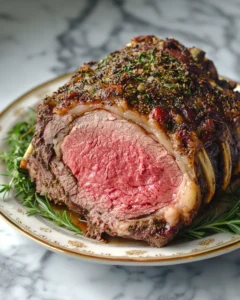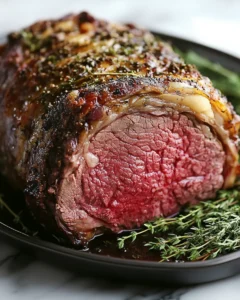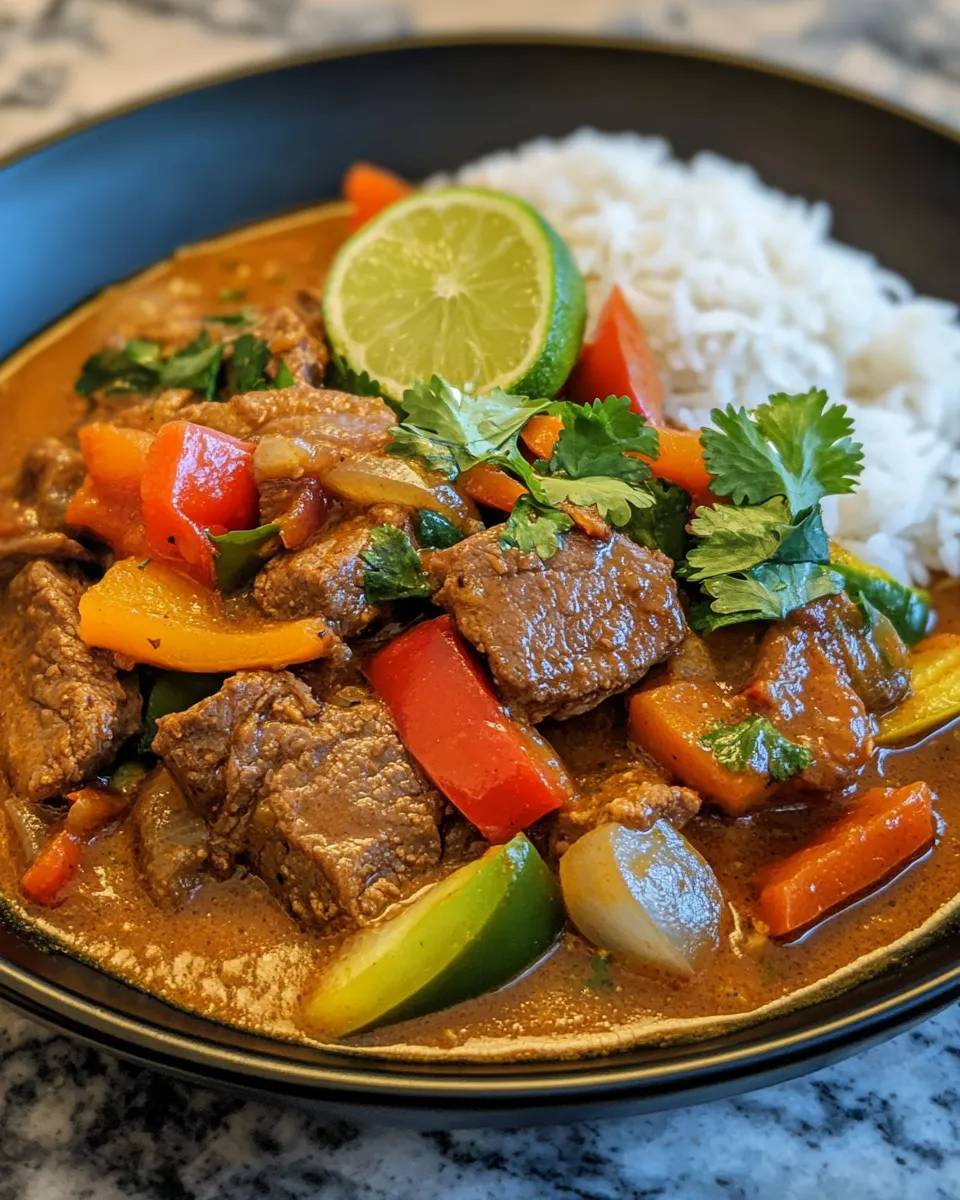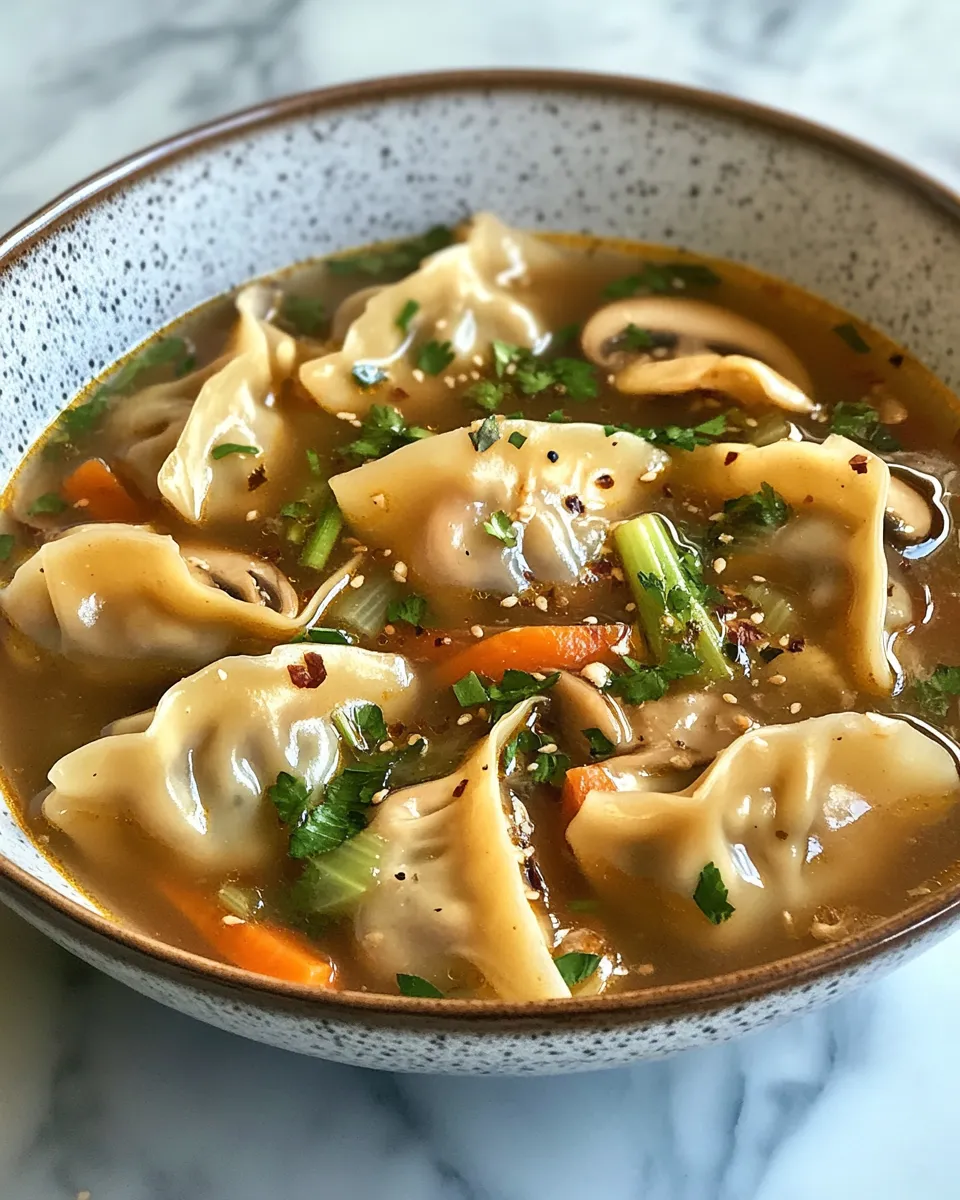There’s something undeniably special about gathering around the table for a hearty, perfectly cooked prime rib dinner. Whether it’s a cozy family evening, a festive holiday celebration, or a special occasion worth marking with care, a medium-rare prime rib brings warmth, indulgence, and a touch of elegance to any meal. Imagine the aroma of a seasoned roast filling your kitchen, the golden crust cracking ever so slightly under your knife, revealing a tender, juicy interior that practically melts in your mouth.
This recipe was inspired by the timeless tradition of Sunday roasts, where families come together to savor a meal that’s both comforting and impressive. Over the years, I’ve perfected this approach to prime rib so that it’s simple enough for home cooks, yet sophisticated enough to serve to guests. From the savory herb rub to the slow-roasting technique that guarantees even cooking, this is the ultimate guide to achieving a restaurant-quality medium-rare prime rib right in your own kitchen.
Ingredients
-
1 (5-7 pound) prime rib roast, bone-in or boneless
-
4 tablespoons olive oil or softened butter
-
6 garlic cloves, minced
-
2 tablespoons fresh rosemary, finely chopped
-
2 tablespoons fresh thyme, finely chopped
-
2 teaspoons kosher salt
-
1 teaspoon black pepper
-
1 teaspoon onion powder
-
1 teaspoon smoked paprika (optional for a subtle smoky flavor)
-
1 cup beef broth (for roasting pan)
-
Optional garnish: fresh herbs for serving
Directions
Prepare the Prime Rib:
The first step to a perfect medium-rare prime rib is proper preparation. Begin by removing your prime rib from the refrigerator at least one hour before you plan to cook it. Allowing the meat to come to room temperature is essential because it ensures even cooking from edge to center. If you were to roast a cold piece of meat straight from the fridge, the outside could overcook while the inside remains underdone. Pat the prime rib dry thoroughly with paper towels. Moisture on the surface can prevent the formation of a proper crust, so don’t skip this step. Drying the meat also helps the seasoning adhere better and ensures that the garlic, herbs, and spices will stick to every surface of the roast.
Take a moment during this step to inspect the roast. If you’re using a bone-in prime rib, check for any excess fat that might need trimming. You want a thin layer of fat left to baste the meat as it roasts, but excessive fat can create uneven cooking. Also, consider tying the roast with kitchen twine if it’s unevenly shaped, which will help it cook more uniformly.
Preheat the Oven:
While your prime rib rests at room temperature, preheat the oven to 450°F (230°C). This high initial temperature is key to achieving a golden, caramelized crust on your roast. The intense heat quickly sears the outside of the meat, locking in juices and flavor. It also gives the roast that classic prime rib look that impresses guests.
Position your oven rack in the lower-middle section of the oven to allow the heat to circulate evenly around the roast. If you have a convection oven, this step is even more effective because the circulating air helps form a consistent crust while maintaining tenderness inside.
Season the Roast:
While the oven preheats, it’s time to prepare your seasoning rub. In a small bowl, combine your choice of olive oil or softened butter with minced garlic, finely chopped rosemary, thyme, kosher salt, black pepper, onion powder, and smoked paprika. This mixture creates a flavorful layer that penetrates the meat during cooking.
Generously rub the mixture over the entire surface of the prime rib. Take your time with this step—make sure to cover every inch, including the sides and any crevices around the bones if you’re using a bone-in roast. Gently press the seasoning into the meat so it adheres well. If you have extra rub, you can massage a little under the fat cap for additional flavor infusion. The combination of herbs and garlic will fill your kitchen with an irresistible aroma as the roast cooks.
Roast at High Heat:
Place the prime rib on a roasting rack in a pan with the fat side facing up. Using a rack is important because it allows hot air to circulate under the roast, preventing the bottom from steaming in its own juices. Put the roast in the preheated oven and let it cook at 450°F (230°C) for 20-25 minutes. This initial high-heat roasting develops a beautiful golden-brown crust that seals in the juices, giving the roast both flavor and visual appeal.
Keep an eye on the roast during this stage to avoid over-browning. If certain areas are browning too quickly, you can tent them lightly with foil. The goal is a uniform, caramelized exterior without burning the seasoning.
Reduce the Oven Temperature:
After the initial sear, lower the oven temperature to 325°F (165°C) to allow the meat to cook gently and evenly. Slow roasting at this moderate temperature ensures that the prime rib cooks from edge to center without overcooking the exterior.
For a medium-rare roast, monitor the internal temperature using a reliable meat thermometer. Insert the probe into the thickest part of the roast, away from the bone. The target temperature before resting is 125°F (52°C). Depending on the size of your roast, this stage can take anywhere from 1.5 to 2.5 hours. Remember that the internal temperature will continue to rise slightly as the roast rests, so it’s important to remove it from the oven a few degrees below your desired doneness.
Add Broth to Roasting Pan:
About halfway through the cooking process, pour 1 cup of beef broth into the bottom of the roasting pan. This simple step adds moisture to the oven environment, preventing the pan drippings from burning. It also creates a base for a flavorful au jus or gravy if you plan to serve the roast with sauce. The broth helps maintain a tender texture and enriches the natural flavors of the prime rib as it cooks.
Rest the Meat:
Once the roast reaches your target internal temperature, remove it from the oven and cover it loosely with aluminum foil. Allow the prime rib to rest for 20-30 minutes before carving. This step is crucial because it allows the juices to redistribute throughout the meat. Cutting into the roast immediately after cooking causes the juices to spill out, resulting in dry slices. Resting ensures that every slice is tender, juicy, and bursting with flavor.
Carve and Serve:
After resting, place the roast on a cutting board. Using a sharp carving knife, slice the prime rib against the grain into ½-inch to 1-inch thick slices. Cutting against the grain ensures each bite is tender and easy to chew. Arrange the slices on a serving platter, and if desired, garnish with fresh herbs for a visually appealing presentation.
Pair the prime rib with your favorite sides for a complete, satisfying meal. Roasted vegetables, creamy mashed potatoes, and simple green vegetables complement the rich, savory flavors of the roast beautifully. For an added touch, drizzle a little of the reserved pan juices or homemade au jus over the slices just before serving. This simple addition elevates the dish and keeps every bite moist and flavorful.
By following these steps carefully, you’ll achieve a medium-rare prime rib that is tender, juicy, and perfectly seasoned—a centerpiece worthy of any celebration or special dinner.
Tips for the Perfect Medium-Rare Prime Rib
-
Use a Meat Thermometer: Relying on internal temperature is the most accurate way to ensure medium-rare perfection. Aim for 125°F (52°C) before resting; the temperature will rise to 130-135°F (54-57°C) during resting.
-
Room Temperature Roast: Starting with a room-temperature roast prevents uneven cooking and helps achieve that perfect pink center.
-
Crust Perfection: Don’t skip the high-heat sear at the beginning—it’s the key to a flavorful crust.
-
Resting is Critical: Skipping the resting period will cause the juices to run out, leaving the meat dry.
Why This Recipe Works Every Time
This recipe balances flavor, texture, and simplicity. The high-heat sear develops a caramelized crust, while the slow roasting at a moderate temperature ensures the meat is evenly cooked. The herb and garlic rub infuses the roast with aromatic depth without overpowering its natural flavor. By following the step-by-step method, even home cooks can achieve a prime rib dinner that feels like it came straight from a five-star restaurant.
Perfect for holiday gatherings, weekend dinners, or any occasion where you want to impress, this medium-rare prime rib is a showstopper. Its rich, tender slices paired with flavorful sides create a meal that’s memorable and satisfying for everyone at the table.
Notes
-
Always use a reliable meat thermometer to ensure accurate cooking.
-
Letting the roast rest is non-negotiable; this step guarantees juicy slices.
-
Customize the herb rub according to your taste preferences—add oregano, parsley, or sage for a slightly different flavor profile.
-
For a visually stunning presentation, serve with roasted cherry tomatoes, glazed carrots, or fresh herbs on top.
-
If cooking for a crowd, consider a second smaller roast or doubling the recipe to ensure everyone gets generous servings.
Prep Time: 20 minutes
Cook Time: 2-2.5 hours
Total Time: 2.5-3 hours
Yield: 8-10 servings
Frequently Asked Questions
Can I cook the prime rib without the bone?
Yes, a boneless prime rib will work perfectly for this recipe. The cooking time may be slightly shorter, so monitor the internal temperature closely. Bone-in roasts retain more moisture and add extra flavor, but boneless versions are easier to carve and handle.
What if I prefer my prime rib more done than medium-rare?
Adjust the internal temperature to match your desired doneness:
-
Medium: 140°F (60°C) after resting
-
Medium-well: 150°F (65°C) after resting
Remember that the roast will continue cooking slightly while resting.
How do I make the au jus?
After roasting, pour the pan drippings into a small saucepan. Add ½ cup of beef broth and simmer for 5-10 minutes. Strain if desired and serve alongside the prime rib for dipping.
Can I prepare the rub ahead of time?
Absolutely! You can mix the herb and garlic rub a day in advance and refrigerate it. Apply it to the meat just before roasting to save time on cooking day.
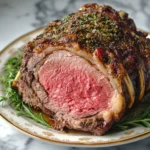
The Best Medium-Rare Prime Rib Dinner Ever
- Total Time: 2.5-3 hours
- Yield: Serves 8–10 1x
Description
A perfectly cooked medium-rare prime rib is the ultimate centerpiece for a cozy family dinner, a festive holiday gathering, or any special occasion that calls for indulgence. The aroma of fresh herbs and garlic roasting alongside a tender, juicy cut of beef fills the kitchen, creating anticipation long before the first slice is served. Inspired by traditional Sunday roasts and years of perfecting the technique, this recipe balances simplicity and sophistication, allowing home cooks to achieve restaurant-quality results with ease. From a golden-brown crust to a melt-in-your-mouth interior, every bite is rich, flavorful, and sure to impress.
Ingredients
-
1 (5-7 pound) prime rib roast, bone-in or boneless
-
4 tablespoons olive oil or softened butter
-
6 garlic cloves, minced
-
2 tablespoons fresh rosemary, finely chopped
-
2 tablespoons fresh thyme, finely chopped
-
2 teaspoons kosher salt
-
1 teaspoon black pepper
-
1 teaspoon onion powder
-
1 teaspoon smoked paprika (optional)
-
1 cup beef broth
-
Optional garnish: fresh herbs for serving
Instructions
-
Remove the prime rib from the refrigerator at least 1 hour before cooking to allow it to reach room temperature. Pat it dry with paper towels to ensure a crisp, flavorful crust.
-
Preheat the oven to 450°F (230°C) to create a high-heat environment for the initial sear, which will form a golden-brown crust and lock in juices.
-
In a small bowl, combine olive oil (or butter), minced garlic, rosemary, thyme, salt, black pepper, onion powder, and smoked paprika. Rub this mixture generously over the entire surface of the prime rib, making sure to cover every inch, including the ends and any crevices around the bone.
-
Place the roast on a rack in a roasting pan with the fat side up. Roast in the preheated oven for 20-25 minutes to develop a caramelized exterior.
-
Reduce the oven temperature to 325°F (165°C) and continue roasting until the internal temperature reaches 125°F (52°C) for medium-rare. Depending on the size, this can take 1.5 to 2.5 hours.
-
About halfway through roasting, pour 1 cup of beef broth into the bottom of the pan. This will create a moist cooking environment and prevent the drippings from burning.
-
Remove the prime rib from the oven and cover loosely with aluminum foil. Let it rest for 20-30 minutes to allow the juices to redistribute throughout the meat.
-
Using a sharp carving knife, slice the roast against the grain into ½-inch to 1-inch thick pieces. Arrange on a serving platter and garnish with fresh herbs if desired. Serve with your favorite sides such as roasted vegetables or mashed potatoes.
Notes
-
Always use a meat thermometer to check for accurate doneness.
-
Resting the roast is crucial for juicy, tender slices.
-
You can prepare the herb rub a day in advance for convenience.
-
Pan drippings can be used to make a simple au jus for serving.
-
Adjust cooking time based on roast size and desired doneness.
- Prep Time: 20 minutes
- Cook Time: 2-2.5 hours


